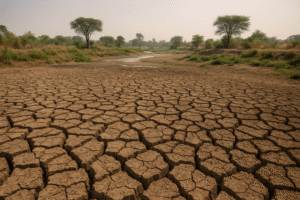💧 Introduction
While 2025’s record-breaking heatwaves dominate headlines, there’s a deeper, quieter crisis devastating lives across India — our country is running out of water.
From dried borewells in cities to cracked fields in villages, the India water crisis 2025 is no longer a warning — it’s a reality. This isn’t a climate event alone — it’s an economic, social, and humanitarian emergency unfolding in real time.
🌍 What’s Causing the Crisis?
The causes are many, and all interconnected.
1. Groundwater Overuse
India relies heavily on underground water — and the numbers are alarming.
-
Punjab leads with 156.87% groundwater extraction, meaning we take out far more water than nature can recharge.
-
The Central Ground Water Board (CGWB) classifies over 75% of Punjab’s blocks as “overexploited.”
-
Cities like Delhi, Hyderabad, and Bengaluru are also rapidly depleting groundwater sources.
India uses more groundwater than China and the US combined, making it the world’s largest extractor.
2. Urban Expansion & Water Mismanagement
As cities boom, lakes are filled, green zones disappear, and rainwater harvesting remains optional, not mandatory.
Municipal water pipes lose 30–40% of water through leaks alone. Demand is growing, but infrastructure isn’t keeping up.
3. Climate Change
Unpredictable rainfall, failed monsoons, and longer summers increase evaporation rates and reduce natural water replenishment.
📍 States in Crisis
• Punjab:
Critically overexploited groundwater. Farmers dig deeper every year — some borewells now exceed 1000 feet.
• Karnataka (Bengaluru):
Water cuts and borewell failures. Families queue with buckets before sunrise. Tankers charge exorbitant rates.
• Telangana (Hyderabad & beyond):
Drought-hit zones. Groundwater falls below safe levels. Authorities ration supply; villagers depend on water tankers.
• Delhi & NCR:
The Yamuna’s water level has dropped significantly. Unauthorized colonies suffer most with weeks of dry taps.
👥 Real People, Real Struggles
In Bengaluru, 38-year-old Arpita, a homemaker, wakes at 4 AM to fill buckets before supply is cut.
“Sometimes the tanker skips our lane. We reuse bathwater for cleaning floors and toilets,” she says.
In Telangana, farmer Ramesh Goud stares at his cracked field.
“This is the third season I’ve lost. The borewell is dead. The nearest pond dried up last year.”
In Delhi’s Sangam Vihar, residents walk 2 km daily for water.
Water mafias charge ₹1,200–₹2,000 for a tanker — unaffordable for daily wage workers.
⏳ Not the First Time: Past Water Emergencies
India has faced water crises before:
-
Chennai, 2019: All four major reservoirs ran dry — the city declared “Zero Day”.
-
Latur, Maharashtra (2016): Trains were sent to deliver drinking water.
-
Bundelkhand drought (2015–2017): Led to mass farmer suicides.
Each was a warning. Today, it’s the entire nation under threat.
📉 Global Standing
The World Resources Institute places India 13th among countries facing extremely high baseline water stress.
Over 600 million Indians face high to extreme water stress
— and 200,000 die every year due to lack of access to safe water (NITI Aayog Report)
🧠 Expert Voices
“India is on the brink of internal water conflict. Without serious water governance, agriculture and urban life will collapse,”
says Dr. Rajendra Singh, known as India’s Waterman.
Even global agencies like Moody’s have warned that India’s water crisis could hurt economic ratings and fuel unrest if not controlled.
🛠️ Is There Still Hope?
Yes — but time is running out. The solution needs to be multi-layered:
1. Rainwater Harvesting Must Be Mandatory
Simple rooftop systems can collect lakhs of litres.
Governments must enforce it in all new and old buildings.
2. Water Budgeting at Home
Track daily usage. Fix leaks. Use dual-flush toilets, re-use greywater. Every drop counts.
3. Reform Agricultural Practices
Promote crops like millets, pulses, and oilseeds, which require less water.
Shift from flood irrigation to drip irrigation in dry regions.
4. Urban Water Recycling
Greywater systems can be installed in societies.
Cities should treat and reuse 80% of their wastewater — currently, we recycle less than 30%.
📣 Conclusion: Water is Not Infinite
The India Water Crisis 2025 isn’t just a future scenario — it’s our present.
The heatwave may end in weeks, but water scarcity will haunt us for decades unless we act.
This isn’t just a government issue — it’s our daily responsibility. Every saved bucket, every rain-harvested drop, every mindful habit matters.
🔗 Further Reading
- India Heatwave 2025: The Silent Emergency (Internal link)
- UN Report on Groundwater Depletion in India (External link)
- Moody’s warning on India’s water risks (External link)



